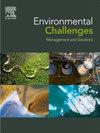Enhancing dairy wastewater treatment: Effects of hydraulic and organic loading rates in vermifiltration systems
Q2 Environmental Science
引用次数: 0
Abstract
Vermifiltration is increasingly recognized as a cost-effective and environmentally sound method for treating concentrated agricultural effluents. This study evaluated how varying hydraulic loading rates (HLRs), and corresponding organic loading rates (OLRs) affect both the treatment efficiency and earthworm biomass dynamics in a vermifiltration system treating dairy wastewater. The experiment was conducted over 60 days using a bench-scale system with a surface area of 0.36 m² and media depth of 45 cm. Four hydraulic loading rates, ranging from 0.5 to 3.0 m³ m⁻² d⁻¹, were tested. These corresponded to organic loading rates between 1.3 and 7.6 kg [COD] m⁻² d⁻¹. System performance was evaluated based on removal efficiencies for COD, TS, TSS, TN, NH₄⁺–N, NO₃⁻–N, TP, and ortho-P. Earthworm biomass gain was also measured as an indicator of biological activity and system health. Removal efficiencies across treatments varied by parameter, with COD ranging from 21 to 52 %, TS from 25 to 34 %, TSS from 43 to 75 %, TN from 33 to 62 %, TAN from 22 to 53 %, and NO₃⁻–N from 21 to 72 %. Optimal removal occurred at the lower HLRs (0.5–1.0 m³ m⁻² d⁻¹) and OLRs (1.3–2.5 kg [COD] m⁻² d⁻¹), likely due to extended hydraulic retention times that enhanced microbial processing and earthworm-mediated degradation. Earthworm biomass peaked at an OLR of approximately 2.5 kg [COD] m⁻² d⁻¹, suggesting that higher organic inputs may surpass the tolerance threshold for earthworm productivity. Conversely, ortho-P removal improved with increasing HLR, indicating that elevated flow rates may enhance phosphorus mineralization. These findings underscore the necessity of optimizing HLR and OLR to balance pollutant removal with biological activity in vermifiltration systems managing dairy effluent.

加强乳品废水处理:过滤系统中水力和有机负荷率的影响
人们日益认识到,过滤是处理浓缩农业废水的一种成本效益高、对环境无害的方法。本研究评估了不同水力负荷率(HLRs)和相应的有机负荷率(OLRs)对乳业废水处理系统中蚯蚓生物量动态和处理效率的影响。实验在60天的时间里,采用了一个表面积为0.36 m²,介质深度为45 cm的实验系统。测试了四种水力加载速率,从0.5到3.0 m³(⁻²d)。这相当于1.3到7.6千克(COD) m⁻²d⁻¹。根据COD、TS、TSS、TN、NH₄⁺-N、NO₃⁻-N、TP和orthp的去除效率对系统性能进行了评估。蚯蚓生物量增重也作为生物活性和系统健康的指标进行了测量。不同处理的去除效率因参数而异,COD在21%到52%之间,TS在25%到34%之间,TSS在43%到75%之间,TN在33%到62%之间,TAN在22%到53%之间,NO₃-N在21%到72%之间。最理想的清除发生在较低的高毒血症(0.5-1.0 m³⁻²d⁻¹)和高毒血症(1.3-2.5 kg [COD] m⁻²d⁻¹),可能是由于延长了水力滞留时间,加强了微生物的处理和蚯蚓的降解。蚯蚓生物量的OLR峰值约为2.5 kg [COD] m(⁻²d⁻¹),这表明更高的有机投入可能超过蚯蚓生产力的耐受阈值。相反,原位磷去除率随着HLR的增加而提高,表明高流量可能会促进磷的矿化。这些发现强调了优化HLR和OLR的必要性,以便在管理乳制品废水的渗滤系统中平衡污染物去除与生物活性。
本文章由计算机程序翻译,如有差异,请以英文原文为准。
求助全文
约1分钟内获得全文
求助全文
来源期刊

Environmental Challenges
Environmental Science-Environmental Engineering
CiteScore
8.00
自引率
0.00%
发文量
249
审稿时长
8 weeks
 求助内容:
求助内容: 应助结果提醒方式:
应助结果提醒方式:


